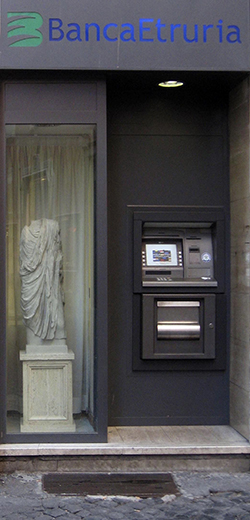Headstone to Hard-drive
9.30 am – 5.00 pm, February 7th, 2015
Central Saint Martins College of Art and Design, London
“The evolution of the “prosthesis”, not itself living, by which the human is nonetheless defined as a living being, constitutes the reality of the human’s evolution, as if, with it, the history of life were to continue by means other than life: this is the paradox of a living being characterized in its forms of life by the non-living – or by the traces that its life leaves in the non-living”
‘Technics and Time: The Fault of Epimetheus No. 1’, Bernard Stiegler [1]
‘Headstone to Hard Drive, Monument to Folly 2’ is the second of three events addressing the issues of exteriorisation, technique and technology as they affect, inform and construct the 'visual' arts. Taking its cue from André Leroi-Gourhan’s theory of exteriorisation, the event will consider the agency of technology and media as a co-author of content, an approach that imbues media with an inherent semiotic and physiologic power and relevance. The aim is to consider the consequences and effects for critical and artistic practices of the ”liberation of memory” performed by technical prosthesis, a “liberation” about which Leroi-Gourhan and others have written extensively.
This second event, following the first symposium in October 2014, draws contributions from artists, philosophers of technology and media, curators, and financial derivatives software providers. It includes presentations by Elie Ayache, Ami Clarke and Richard Cochrane, Steven Claydon, Felicity Colman, Annabel Frearson, Sarah Jones and with a keynote address by Bernard Stiegler.
The growth of digital databases, acting simultaneously as storage, circulation and calculation technologies, magnifies the artistic dialogue between authorship and automation; a socio-cultural dialogue familiar within the visual arts from the histories of photography and the readymade. Both of these historic ‘techniques’ drove a wedge into the traditional supports of aesthetic experience; communication and production. This is the backdrop against which the three symposia question aesthetic theory’s robustness in the light of technological development. Whether we view technics either as extensions or as appropriations of human physiology, the question remains: how can aesthetics, mired in anthropocentric bias and organicist analogy, make space for the inorganic or the technical? Where now are we able to locate a spectator moving between the sentient human and the auxiliary non-human or the auxiliary human and the sentient non-human?
Whilst the discursive topic incorporates contemporary developments in technology, the approach of the symposia is not to consider such technologies’ import as existing in developmental isolation, rather they are seen to have retrospective agency, in historical reconstruction, in the obsolete and in the survival of the anachronistic. Also, technology gains calculative and prospective agency, not through an unfolding end-point but in a ‘purchase’ of, and a ‘loan’ to, the future. It is through a chiasmic image of the present, a revolving door, that the con-temporality of technology is proposed.
The series of events bridge historical and contemporary mnemo-techniques; the alphabet; financial trading software; micro-processing; extra-terrestrial architecture; plaster-cast replicas of antique statues; phonography; photography; 3D data capture; heritage industries; archives. These are examples of mnemo-techniques and technologies, derived from the architectural monument to the semi-conductor microchip - from the headstone to the hard drive - encompassing the actual and the virtual.
This question of the temporality of technology is developed across the three events by exploring archaeological and historical approaches and their ability to provide points of purchase for considering the impasse of aesthetic theory when faced with the technical. A tension is staged between the epistemological value of technical memory and a media-archaeological understanding of technology; concern with data, material fragments, “decisive mutations”[2]. What noise, supplementarity or redundancy might accompany this tension?
The third event will take place at The British School Rome on June 26th 2015, specifically engaging distinctions of method between history and archaeology, examining their differing potential for critical/artistic practice.
[1] Stiegler, Bernard, Richard Beardsworth, and George Collins. Technics and Time: The Fault of Epimetheus No. 1. Stanford, Calif: Stanford University Press, 1998. p.50
[2] Ernst, Wolfgang and Parikka, Jussi. ‘Digital Memory and The Archive’, University of Minnesota Press, 2013. p.48
Tickets for this event are free and available from Eventbrite:
https://www.eventbrite.co.uk/e/headstone-to-hard-drive-monument-to-folly-2-tickets-15065956682

Headstone to Hard-drive, 7 Feb 2015